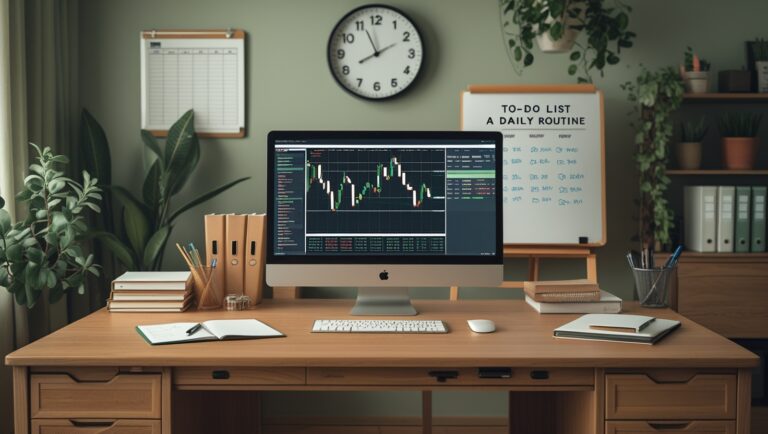How to Read Stock Charts Like a Pro (Beginner’s Step-by-Step Guide)
How to Read Stock Charts Like a Pro (Beginner’s Step-by-Step Guide)
Want to learn how to read stock charts like a pro? I remember when I first started trading—it was overwhelming. In this guide, I’ll show you a step-by-step approach for beginners to understand charts, spot trends, and make confident trading decisions. I’ll also share the software I use daily to analyze the market and my proven method to pay my bills with stocks.

Table of Contents
Why Learning to Read Stock Charts Matters
When I first opened my first stock chart, I felt lost. There were candles, lines, and indicators everywhere. Understanding how to read stock charts is the foundation of trading success. Without it, you’re guessing your trades, which can lead to losses and frustration.
With the right knowledge and tools, anyone can learn to spot trends, identify support and resistance, and make informed trading decisions. Reading charts is not just for professional traders—it’s for anyone who wants to trade confidently.
Step 1: Understanding Candlestick Charts
The first thing I learned was how to read candlestick charts. Each candle represents price movement over a specific period, showing the open, high, low, and close.
Candlesticks help me see trends and potential reversals quickly. When beginners understand basic patterns, like doji, hammer, and engulfing candles, it becomes much easier to interpret the market.
Step 2: Identifying Trends
After learning candlesticks, I focused on identifying trends. Markets move in three directions: uptrend, downtrend, or sideways. Recognizing the trend helps me decide whether to buy, sell, or hold.
I personally use moving averages and trend lines to confirm trends. This step alone significantly improved my trading results and reduced guesswork.
Step 3: Learning Support and Resistance
Support and resistance levels are crucial. These are the price points where a stock tends to reverse or pause.
I use charting software to mark these levels and watch how the stock reacts. Knowing support and resistance allows me to plan entries and exits and manage risk more effectively.
Step 4: Using Indicators Wisely
Once I mastered trends and levels, I added a few technical indicators to my charts. My go-to indicators include RSI, MACD, and volume. They help me confirm signals and avoid false moves.
As a beginner, I found it tempting to add every indicator, but simplicity is key. I focus on a few that provide meaningful insights without overwhelming me.
Step 5: Setting Alerts and Tracking Signals
One feature that changed everything for me was setting alerts. I can track price levels or indicator triggers and get notified instantly.
This allows me to stay disciplined and react quickly without staring at charts all day. Alerts are a game-changer for beginners who want to trade confidently.
Step 6: Choosing the Right Charting Software
Having the right charting software makes learning and trading much easier. After testing several platforms, I recommend TradingView.
I love TradingView because it’s beginner-friendly but powerful, has real-time data, tons of indicators, and a large community sharing scripts and strategies. It’s the software I use every day to analyze stocks and plan trades.
Step 7: Practicing With Real Charts
Reading charts is a skill, and like any skill, it improves with practice. I spend time daily reviewing charts, spotting patterns, and seeing how the market reacts.
I also track my trades in a journal, noting what worked and what didn’t. This practice helped me refine my strategy and become more confident in my decisions.
Step 8: Applying a Proven System
Knowing how to read charts is powerful, but combining it with a structured system takes results to the next level.
That’s why I created my ebook, How I Pay My Bills Monthly With Stocks. It teaches beginners how to combine chart reading with a step-by-step method to generate monthly income from trading.
Using my system alongside TradingView has been the key to consistent and stress-free trading.
Conclusion: Start Reading Charts Like a Pro Today
Learning how to read stock charts like a pro doesn’t have to be intimidating. By following a step-by-step approach—candlesticks, trends, support and resistance, indicators, alerts—you can start trading with confidence.
If you want a trusted charting tool to practice these steps, I recommend signing up for TradingView here: https://www.tradingview.com/?aff_id=155687
To learn my complete system for turning chart analysis into real monthly income, check out my ebook: https://stockflowreport.gumroad.com/l/paybillswithstocks
Start your journey today, and take control of your trading success!
When I first started learning how to read stock charts, it felt like trying to decode a foreign language. Each candle, line, and number seemed meaningless until I learned what they represented. That moment of clarity changed the way I approached trading forever.
One thing I quickly realized is that beginners often get overwhelmed by too many indicators. I made the mistake of adding every single one I could find. What I discovered is that focusing on a few core indicators makes chart reading much simpler and more effective.
Learning to spot trends became a game-changer for me. Once I understood the difference between an uptrend, downtrend, and sideways movement, I could make informed decisions instead of guessing. It gave me confidence in every trade.
Understanding support and resistance levels was another turning point. I started marking these levels on my charts and watching how prices reacted. It allowed me to plan my trades better and reduce unnecessary risk.
I also learned that volume is one of the most underrated indicators. By analyzing trading volume along with price movement, I could see whether a trend was strong or likely to reverse, which helped me avoid false signals.
Practicing with real charts every day made a huge difference. I didn’t just read about patterns—I tracked them, tested strategies, and adjusted my approach based on real market behavior. Practice builds confidence faster than any guidebook.
Setting alerts on price movements and indicators saved me countless hours. Instead of constantly staring at charts, I could focus on other things while still being ready to act when opportunities appeared.
Customizing my chart layout helped me stay organized and efficient. I could have my favorite indicators, watchlists, and notes all in one place. This simple step made reading charts less intimidating and more enjoyable.
I also found it helpful to review historical charts. Looking at past trends and patterns gave me insights into how certain stocks behave, which made it easier to predict potential moves in the future.
Combining chart reading with a structured trading plan was key to turning knowledge into results. That’s why I created my ebook, How I Pay My Bills Monthly With Stocks. It shows exactly how I use chart reading to plan trades and generate income.
Even as a beginner, having the right tools made a huge difference. Using TradingView, I could access real-time data, apply indicators, and track my strategies effortlessly. It gave me the confidence to start trading seriously.
Finally, I realized that reading stock charts isn’t just about understanding numbers—it’s about building discipline, confidence, and a mindset for success. Every trade I make now is informed, measured, and part of a plan I trust.

Stay ahead in the stock market! Subscribe to our newsletter and receive exclusive stock flow reports, trading insights, and actionable tips directly in your inbox. Join thousands of traders who get our updates first.







